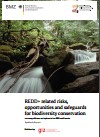REDD+ related risks, opportunities and safeguards for biodiversity conservation – a survey of issues and options in Lao PDR and Ecuador
-----------------
 Intact ecosystems – particularly forests – contain significant amounts of carbon. Their conservation is therefore a relatively cost-efficient way to protect the climate. On this basis, REDD+ (Reducing Emissions from Deforestation and Forest Degradation) intends to create incentives for developing countries to reduce emissions through the protection and better management of forests. Apart from mitigation effects, REDD+ aims at generating multiple co-benefits for nature and people, such as the conservation of biological diversity.
Intact ecosystems – particularly forests – contain significant amounts of carbon. Their conservation is therefore a relatively cost-efficient way to protect the climate. On this basis, REDD+ (Reducing Emissions from Deforestation and Forest Degradation) intends to create incentives for developing countries to reduce emissions through the protection and better management of forests. Apart from mitigation effects, REDD+ aims at generating multiple co-benefits for nature and people, such as the conservation of biological diversity.
There are, however, also some concerns associated with the implementation of REDD+, such as potentially negative impacts on biodiversity. These include ecological risks like the displacement of deforestation and degradation to areas which are low in carbon but rich in biodiversity or the reforestation with non-native tree species.
Safeguards can help to reduce such risks and maximise benefits for biodiversity conservation. In 2010, a first series of safeguards was adopted at the international level by the parties to the UNFCCC. In addition, other safeguard frameworks support the consideration of biodiversity in ongoing REDD+ processes, such as the Strategic Environmental and Social Assessment (SESA) under the Forest Carbon Partnership Facility (FCPF) or the REDD+ Social and Environmental Standards (SES).
In the future, the effectiveness of such standards will depend particularly on how they are defined, implemented and monitored on the national level. To inform such decision-making processes, BMZ has commissioned an expert study in 2011 to analyse existing conditions and experiences with regard to biodiversity safeguards for REDD+ in two partner countries of German development cooperation: Ecuador and Lao PDR.
This synthesis report summarises the key findings identified from interviews with relevant stakeholders and a thorough literature review, and makes a number of recommendations for the possible future consideration of potential risks and opportunities for biodiversity conservation in the context of REDD+, especially for policies, activities, projects and programmes supported by development cooperation. It is intended as a technical input to inform decision-makers and practitioners on how to systematically enhance the synergies between REDD+ and the implementation of the Convention on Biological Diversity.
---------------

